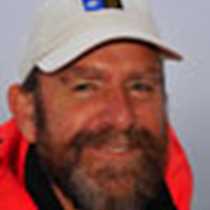Hinlopen Strait and Austfonna, Northeast Svalbard
After trudging through unseasonal snow yesterday, we got caught in an unseasonal gale today. There is a deep low to the east of us, pulling in powerful winds from the north. We surfed down Hinlopen Strait and squealed to a halt off Cape Fanshawe at 0630. Broadside on to churning seas, we nosed in to look at the dramatic sheer cliffs of the Cape. The stacks and ledges of these weathered crags are home to one of the greatest concentrations of Brünnich’s guillemots in Svalbard. At the height of the season, with adult birds and chicks all packed tight together on the ledges, there may be over 150,000 individuals thronging these cliffs. Even in gale force winds they were still winging in from the sea with fish in their beaks, last takeaway meals for their chicks which have already started to depart. The adult birds call each chick off the ledges when only one-third grown, and though barely able to fly, once they hit the sea they can swim like fish. The sea is where they belong, and the each male parent leads his chick out into open water where they will spend the winter learning to dive, fish and feed themselves. Even in these extreme conditions, we were given a display of extreme watersports from the guillemots, white-water canoeing up waves, surfing down the steepest faces, kite boarding off the crests and sub-aquarobics.
As we turned away south, the weather closed in around us, fog obscuring all but the closest waves which were smeared with white streaking from the strong winds. This gave us a blessed respite from the endless dramatic scenery we have had to endure so far, and snug inside our foggy cocoon we enjoyed a string of lectures from our talented, handsome and endearingly modest naturalists: Carl Erik gave an introduction to Svalbard illustrated with his own beautiful photographs, Ian described the bizarre lifestyles of Arctic seabirds, and Magnus gave a dramatic insight into the greatest of northern predators, the Polar Bear. By the time we emerged, tempted out by the smell of newly baked scones, the sun was out and we were following the shore of Nordaustlandet. Sharp eyes spotted a white blob among russet boulders above the shore; the telescopes revealed the detail - a young bear feeding on something among the rocks. Beyond him, on green and tan slopes below a high snowfield, seven reindeer grazed, gleaming in the bright afternoon sunshine.
Our final treat was a sunlit journey along the face of Austfonna, the biggest icecap in Europe. An ivory gull flew along the blue deeply-scalloped glacier face. Fulmars foraged where thin trickles of meltwater sprinkled the sea below. Several bearded seals bobbed up from feeding on the seabed; the waters along this face are enriched by nutrients from the ice and support a richer benthic foodchain. Further out we encountered small groups of harp seals surging among the chips of drifting glacial ice. So much packed into one Arctic day: we have lived through four seasons in fourteen hours, a fierce winter gale, a foggy spring morning, a sunlit summer afternoon and a still autumn evening as we steam north-east round the coast of Nordaustlandet in search of pack ice.




